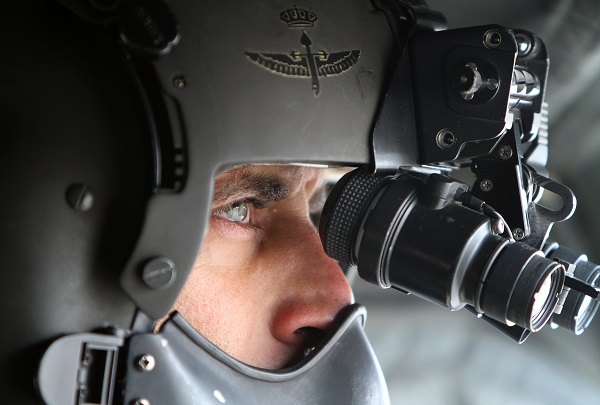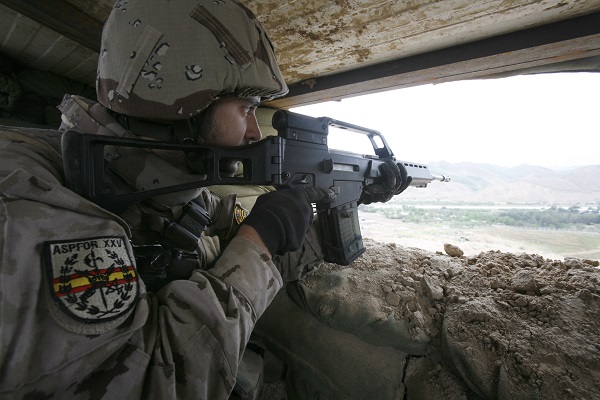- Home
- Army Structure
- Texto no traducido
- BRIEX2035
2035 BRIGADE. A new concept for future conflicts.

Next years, the Spanish Army will have to act in unpredictable and dynamic environments with a continuous growth of complexity. This, together with the quick technological advances, the possibility of accessing to technology used by civilian and military people, by opponent powers and threats, as well as the hyperconnectivity, great influence and omnipresence of the mass media and social networks, forces an evolution concerning the concept of its Brigades -combat unit regarding the operational land forces-. In this sense, future Brigades will be equipped with the necessary capacities such as Integral Combat System, being acquired by all of them in a global way.
2035 Brigade is the model designed for the accommodation of the Spanish Army to the operational environment; it is expected to be ready by the horizon of this year.
In this new model, the definition of the technologies which are going to be added, the organization, the tactics or the procedures for combat require an experimental process. For that, it has been designated "Rey Alfonso" Brigade, the 2nd of the Spanish Legion, as 2035 Experimental Brigade (BRIEX). It is in charge of conducting the experimental activities which make easier the design of the brigade of that year. The decision of choosing the Legion's Brigade has been taken because it has a Manoeuvres and Shooting Field in "Álvarez de Sotomayor" base, in Viator (Almería) -where it is located the General Staff of the unit- apart from being next to the Training and Doctrine Command, located in Granada. In addition, the technological demostrators used will be mainly based on the 8x8 Vehicle, whose first units will replace the current BMR, equipped in that Brigade. The experimental phase will start in November of 2018 and it will finish, once the objectives have been reached, in the second semester of 2019.
The main characteristic of the 2035 Brigade is that it will be based on technology, which will allow a bigger combat power with less personnel -around 2.800 soldiers-.

Technological Projects Test
For that reason, during the experimental test, different projects, such as those mentioned before like the VCR 8x8, will be tested, as well as other teams and systems which may be received before November of 2018, and during the period of testing too. Similarly, systems of combat simulation will be used. When the phase of experiences finishes it will be elaborated the Transition Plan, which will allow the beginning of the accommodation process of the current brigades to the concept of 2035 Brigade. This will be activated in sequence, so that any unit can adquire a different or privileged profile in comparison with the rest because of the order established in its implementation, or because of any other circunstance. This happens in order to establish suitable conditions in all the Brigades for their use in the whole spectrum conflict -in both, lineal and non-lineal environments-, being interoperable with other allied armies forming part of the Joint Force.
The transformation of the Army, a collective project.
Before the testing phase, it has been established a Centre of 2035 Force Studies in the Plan Division (DIVPLAN) of the General Staff of the Spanish Army (EME in Spanish), and it has been constituted the Group of 2035 Working Force, headed by the chief of the DIVPLN. This has permanent spokepeople in the different Army General Staff's Divisions and General Secretary, as well as contributions of the different Force Commands, Force Support and other elements of the General Staff of the Spanish Army (CGE in Spanish) which have been determined, apart from the Military Emergencies Unit and the Chief of General Staff of the Spanish Army's cabinet (JEME).
Support cellAt basic level, the Force Commands, the Force Support and CGE elements which may be determined, will form, with permanent nature, Support Cells to the 2035 Force Studies and to the Experimental Brigade. The Land Force (FUTER in Spanish), with the support of different Commands through the previously mentioned Working Group, will be in charge of the elaboration of the Testing Plan. Th chief of the FUTER, on the other hand, will head the management of the testing process, which will be conducted by the Legion's Brigade. For that, a Working Group will be organized in order to elaborate the Testing Plan, with the participation of the Canary Island Command, the High Readiness Force Land Headquarters, the Logistic Support Command, the Training and Doctrine Command, the General Inspection of the Spanish Army, the Operational Logistic Force and the Head of the Information and Telecommunications Systems, and the Technical Assistance.
Furthermore, the chief of the FUTER will have the support of the Training and Doctrine Command (MADOC in Spanish) in the management of the testing process, particularly when dealing with doctrine, with applying what has been learnt and with the national and international research projects. Likewise, the MADOC will ensure the use of the Manoeuvres and Shooting Fields and Training Centres, necessary for the performance of the experimental activities, and finally, it will be established a support element for the collection of the lessons learnt in the BRILEG.In the case of the Logistic Support Command, it will raise a I+D+i Plan with projects which will take place in 2035.
The calendar of tasks proposes that the structure of the Support Cells do not delay beyond the 31st of May. The experimental phase will start the 1st of November and it will finish the 31st of December in 2019. From the results of this experimental phase a Transition Plan will be obtained, and in the meanwhile, the EME will develop during 2018, the necessary studies which will allow a definition of the Combat Support and Logistic Combat Support Brigades. These Brigades will complete their studies in land capacities during 2035.
THIS IS HOW OUR NEW BRIGADE WILL BE
(COMBAT FUCTIONS)

LOGISTIC SUPPORT
The variety of different stages will place logitics towards opposite challenges. In some of these scenaries, a disperse force in large spaces, and with a disperse, diffused, discontinued and changing threat too, should be supported; in other cases, it will be necessary to face an enemy similar to the own forces, with the capacity of interfering in the logistical manoeuvre through fire and the degradation of the information and telecommunication systems.
The necessity of congregating the new human resources and materials available in combat units will require a reduction to the minimum of the logistical mark. For that, it is essential to face the rationalization of all the phases of logistical cycle and to have a system full of logistical information.
The capacity of self-testing of the materials, the predictions of problems, the simplification of the maintenance tasks, the best qualification of the personnel, the availability of the tutorial systems or "Telemecanique", the possibility of generating spare parts through 3D printing, as well as the robotization and automation, will allow a reduction of the personnel required in maintenance tasks and in operations such as the conduction and preparation of loads and its management.
On the other hand, the expected dispersion of the units, the difficulties of evaluation and the necessity of reducing losses, will oblige to have bigger capacities of vanguard stabilization. For that, it would be necessary a qualified personnel, from the combatatant to the facultative personnel, going through figures such as the "paramedic"; as well as the availability of technical aids and actives substances and tutorial and telemedicine systems.
INTELLIGENCE
The technological evolution will make possible a significant raise of the number of sensors in the battle field and, at the same time, this will raise the difficulty of integration of the information. The advances in artificial intelligence equip in a higher level the autonomy of the sensors, which will allow the use of swarms sensors or swarms nets. Other aids with a raising importance will be those obtained from open resources (including social media) or the biometric identification. Furthermore, it will be necessary to have specified sensors for combats in subsoil and in urbanized areas. The artificial intellingence systems will be, in this aspect, essential for making easier the management of information, analylisis, fusion and dissemination of Intelligence.
COMMAND
It is required a command and control system which incorporates all the combat functions in useful time, providing just one and updated visualization of the relevant operational information (Common Operational Picture). The development of CIS aids for the support of the command and control system would allow the establishments of reduced, moving and with a low electromagnetism mark command posts, which will guarantee the link in any situation.
MANOEUVRE
The mobility and autonomy of the vehicles will allow units to act in a disperse way, combining presence points, as well as, congregating in a quicker way the effects whenever it will be necessary. The protection and survival of the personnel posted in land platforms will be an essential characteristic, so it will be essential to combine the shields with detection systems (active and pasive), neutralization and destruction agains all kind of threats. The irruption of autonomous and semi-autonomous vehicles will be needed for the combatants in order to improve the survival of units because they will replace combatants in some tasks, as they are more qualified (support, recconnaissance, and even support weapons), multiplying, in that way, the combat power.
- Influence in the environment:
In the future it will be essential to have a land manoeuvre together with the information branch, so the forces should have specific units. This manoeuvre will materialize, from the lower levels at tactical level, thanks to the operational specific teams that encompasss PSY OPS activities (psychological operations), CIMIC (Civic-military cooperation) and communication. The Future Operations of Information Regiment, which will be created before the 1st of January in 2019, will provide the teams required for materializing the manoeuvre of the information at brigade and at battalion level, through teams which include three types of activities, among others. It will be necessary to have with these capacities in the training of the Experimental Brigade before the 1st of January of 2019. On the other hand, the support from the reach-back will allow the creation of products and the analysis from national territory.
- Operation in the cyberspace:
The cyberwar will be a growing threat more letal each time. It will raise it effects as CIS systems of command and control advance. The operation in the cyberspace will contribute to the manoeuvre in the information branch.
- Mobility and countermobility:
The Unit of Engineers belonging to the Brigade should have modular capacities, so that they can support different manoeuvre units, keeping the capacity of support to the joint group of the Brigade. In order to raise this capacity, without raising the personnel, different technological advances should be integrated in the Engineers' sections.
FIRES
The Land Forces will have to add the joint fires in the manoeuvre. Furthermore, in 2035, it will still be crucial to have specific land fires, because of their capacity consisting in giving continuous support during 24h all the days of the week. The units of fire support should be able to act, simultaneously, benefeting small units and congregating all the effects whenever they are required. When dealing with the integration of fires, in the element of fire support (FSE in Spanish) of the Battalion, there will be an integration of the artillery, morter and helicopter fires. In that sense, the Brigade will have, apart from that, a JTAC team (Joint Tactical Air Controler) which will provide the control of terminal attacks. In the case of the use of electromagnetic energy with offensive aims, systems technologically developed will be needed in order to allow a disarticulation of the enemy systems whenever it will be necessary.
PROTECTION
Concerning aerial threats, apart from aircrafts and helicopters, it is expected to have a boom consisting in including Unmanned Aerial Vehicles (RPAS) and "slow movers" (light aircrafts, ultralight planes, etc.); as well as missiles, morters and artillery projectiles and small ground-to-air missiles (RAM in Spanish). The tactical groups will have systems able to neutralize RPAS threats and to provide an active defense against RAM. Apart from that, the Land Forces will have anti-aircraft defense units at low height. The incorporation of missile and cannon systems will give a bigger protection to the Brigade.
On the other hand, it is necessary to have C-IED capacity (against improvised explosive devices) until the lowest levels. In the future, the C-IED capacity will need to include a bigger flexibility when dealing with its aids, in order to adapt itself to the change in the procedures and techniques.
The proliferation of NBC threats (specially biological and chemical threats) will involve a better capaticy of detection, with detectors at combatant level. The platform will need protection towards the NBC-R and polluting and industrial emissions if they operate in urbanized areas. Small units will have to conduct a fisrt decontamination. It will be necessary to provide electronic war light teams in order to contribute to the protection of the force when dealing with risky situations with the enemy.
ARMY UNITS
- Araba Álava |
- Albacete |
- Alicante |
- Almería |
- Asturias |
- Ávila |
- Badajoz |
- Barcelona |
- Burgos |
- Cáceres |
- Cádiz |
- Cantabria |
- Castellón |
- Ceuta |
- Ciudad Real |
- Córdoba |
- A Coruña |
- Cuenca |
- Girona |
- Granada |
- Guadalajara |
- Gipuzkoa |
- Huelva |
- Huesca |
- Islas Baleares |
- Jaén |
- León |
- Lleida |
- Lugo |
- Madrid |
- Málaga |
- Melilla |
- Murcia |
- Navarra |
- Ourense |
- Palencia |
- Las Palmas |
- Pontevedra |
- La Rioja |
- Salamanca |
- Segovia |
- Sevilla |
- Soria |
- Tarragona |
- Santa Cruz de Tenerife |
- Teruel |
- Toledo |
- Valencia |
- Valladolid |
- Bizkaia |
- Zamora |
- Zaragoza



